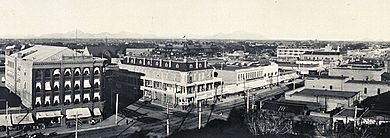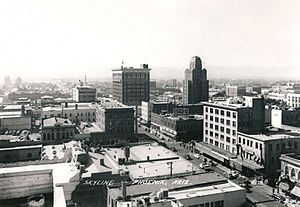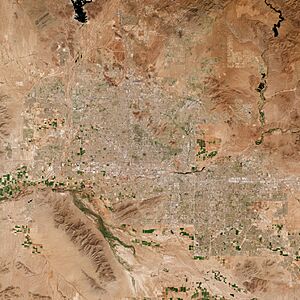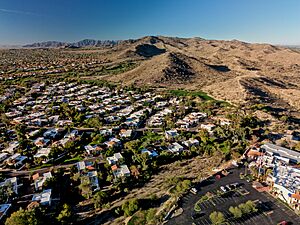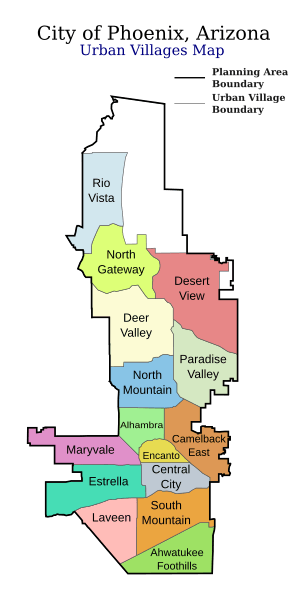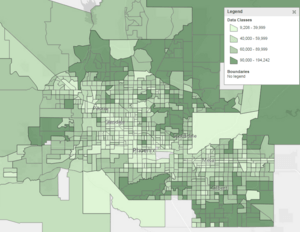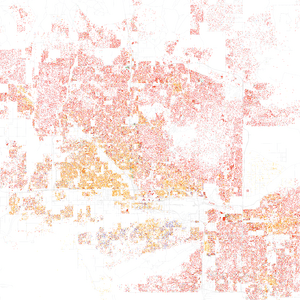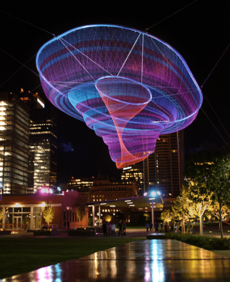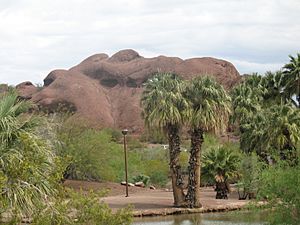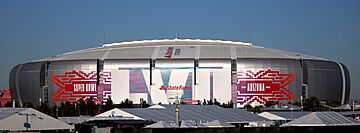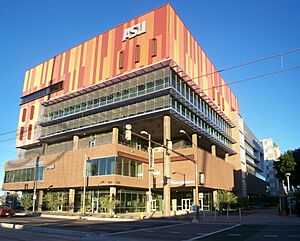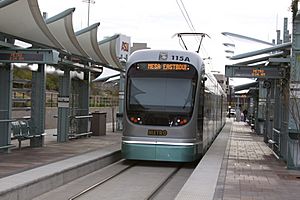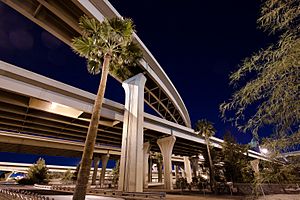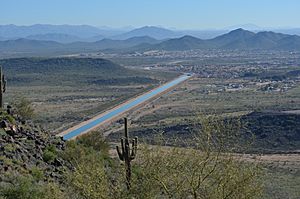Phoenix, Arizona facts for kids
Quick facts for kids
Phoenix
|
|||
|---|---|---|---|
|
|||
Nickname(s):
|
|||
| Country | United States | ||
| State | Arizona | ||
| County | Maricopa | ||
| Settled | 1867 | ||
| Incorporated | February 25, 1881 | ||
| Founded by | Jack Swilling | ||
| Named for | Phoenix, mythical creature | ||
| Government | |||
| • Type | Council–manager | ||
| • Body | Phoenix City Council | ||
| Area | |||
| • State capital | 519.28 sq mi (1,344.94 km2) | ||
| • Land | 518.27 sq mi (1,342.30 km2) | ||
| • Water | 1.02 sq mi (2.63 km2) | ||
| Elevation | 1,086 ft (331 m) | ||
| Population
(2020)
|
|||
| • State capital | 1,608,139 | ||
| • Estimate
(2021)
|
1,624,569 | ||
| • Rank | 11th in North America 5th in the United States 1st in Arizona |
||
| • Density | 3,102.92/sq mi (1,198.04/km2) | ||
| • Urban | 3,976,313 (US: 11th) | ||
| • Urban density | 3,580.7/sq mi (1,382.5/km2) | ||
| • Metro | 4,845,832 (US: 10th) | ||
| Demonym(s) | Phoenician | ||
| GDP | |||
| • Metro | $362.087 billion (2022) | ||
| Time zone | UTC−07:00 (MST (no DST)) | ||
| ZIP Codes |
85001–85024, 85026-85046, 85048, 85050-85051, 85053-85054, 85060-85076, 85078-85080, 85082-85083, 85085-85087
|
||
| Area codes |
|
||
| FIPS code | 04-55000 | ||
| GNIS feature ID | 44784 | ||
Phoenix is the capital and largest city in the state of Arizona. As of 2024, about 1.66 million people live here. It's the fifth most populated city in the United States. Phoenix is also the most populated state capital in the country.
The city is the biggest part of the Phoenix metropolitan area, also known as the "Valley of the Sun." This large area has about 4.95 million people. Phoenix is located in Maricopa County. It is the largest city in Arizona by both population and size.
Phoenix started as a farming community in 1867. It became a city in 1881. In 1889, it was named the capital of the Arizona Territory. Early farmers grew crops like alfalfa, cotton, and citrus. These were important to the local economy for many years. People called cotton, cattle, citrus, climate, and copper the "Five C's" because they were so important. After World War II, new technology companies came to Phoenix. Also, air conditioning made the hot summers much easier to handle.
Phoenix is a major cultural hub in Arizona. It sits in the Sonoran Desert and is known for its very hot desert climate. The city has grown quickly over the years. From the mid-1960s to the mid-2000s, its population grew by about four percent each year. By 1980, it was one of the ten biggest cities in the nation. Many people in Phoenix are of Hispanic background, making up about 42% of its population.
Contents
- Phoenix's Past: A Look Back
- Phoenix's Location and Landscape
- Plants and Animals in Phoenix
- Phoenix's Climate
- People and Culture in Phoenix
- Phoenix's Economy
- Arts and Culture in Phoenix
- Sports in Phoenix
- Parks and Outdoor Fun
- Learning and Education
- Media and Entertainment
- City Services and Transportation
- Famous People from Phoenix
- Phoenix's Sister Cities
- See also
Phoenix's Past: A Look Back
Ancient Times and Early Settlers
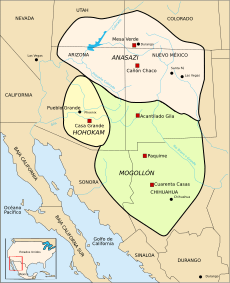
The Hohokam people lived in the Phoenix area for 2,000 years. They built about 135 miles of irrigation canals. These canals helped them farm in the desert. Some of their old canal paths are still used today. They also traded with other groups far away. It is thought that droughts and floods between 1300 and 1450 caused the Hohokam to leave the area.
After the Hohokam left, other tribes used the land. These included the Akimel O'odham, Tohono O'odham, and Maricopa tribes. The Akimel O'odham were the main group. They lived in small villages and used irrigation systems. They grew corn, beans, squash, cotton, and tobacco. The Maricopa people joined them for protection. The Tohono O'odham also lived in the region. They were seasonal farmers who used rainwater.
After the Mexican–American War in 1848, the Phoenix area became part of the New Mexico Territory. In 1863, the town of Wickenburg was founded nearby. In 1865, the Army built Fort McDowell to prevent conflicts with Native Americans. This led to the first new settlement in the valley since the Hohokam left.
How Phoenix Began and Grew
The story of Phoenix begins with Jack Swilling. He was a veteran who saw a chance to farm in the Salt River Valley in 1867. He noticed old canals dug by Native Americans. Swilling started a company to dig new canals and grow crops. Other settlers soon arrived. One of them, Lord Darrell Duppa, suggested the name "Phoenix." This name came from the mythical bird that rises from ashes. It meant a new city rising from the ruins of an old civilization.
The new town was officially recognized on May 4, 1868. The first post office opened soon after. In 1870, a new town site was chosen. This became downtown Phoenix, laid out in a grid pattern. On February 12, 1871, Maricopa County was created. Phoenix was now part of this new county.
The town grew quickly in the 1870s. By 1875, it had a telegraph office and many businesses. In 1881, Phoenix officially became a city. Its population was about 2,500 people.
The railroad arrived in the 1880s. This helped Phoenix become a trade center. Goods could now reach markets across the country. The Phoenix Chamber of Commerce was formed in 1888. In 1889, Phoenix became the capital of the Arizona Territory. The Santa Fe, Prescott and Phoenix Railway arrived in 1895. This connected Phoenix to northern Arizona.
Phoenix in the Early 1900s
On February 25, 1901, the permanent Capitol building was dedicated. The Carnegie Free Library opened in 1908. In 1902, the National Reclamation Act was signed. This allowed dams to be built for water and electricity. The first dam built under this act was the Salt River Dam#1. It opened in 1911 and was the largest masonry dam in the world at the time. It created a lake east of Phoenix.
On February 14, 1912, Arizona became the 48th state. Phoenix became a state capital. In 1913, Phoenix changed its government system. It became one of the first U.S. cities to use a council-manager system. By 1920, Phoenix's population reached over 29,000. The city's first skyscraper, the Heard Building, was built in 1920. Sky Harbor Airport opened in 1929. The city bought it in 1935.
In 1930, the Calvin Coolidge Dam was dedicated on the Gila River. During the 1930s, Phoenix became known as "The Valley of the Sun." This was an advertising slogan to attract tourists. By 1930, the population was over 48,000.
During World War II, Phoenix became a center for making military supplies. Three air force fields and two pilot training camps were in the area.
Post-War Growth and Changes
After World War II, many soldiers who trained in Arizona returned to live there. This led to a huge population boom. Industries like Motorola and Intel moved to Phoenix. They saw a large workforce and opened factories. By 1950, over 105,000 people lived in the city.
The invention of air conditioning helped Phoenix grow even more. It made the hot summers much more comfortable. In the 1950s, there was a lot of new construction. However, this growth was not equal for everyone. Some neighborhoods were mostly white, and others were for African-American and Mexican-American communities.
Phoenix from the 1960s to Today

Population growth continued rapidly. More businesses came, especially in electronics. Tourism also grew a lot. In 1965, the Phoenix Corporate Center opened as the tallest building in Arizona. Many other buildings were built as the city expanded.
In 1968, Phoenix got its first NBA team, the Phoenix Suns. They played at the Arizona Veterans Memorial Coliseum. The Central Arizona Project was approved in 1968. This project helped bring more water to Phoenix and other cities.
In the 1970s, downtown Phoenix saw a lot of new construction. The city also started the "Phoenix Concept 2000" plan. This plan divided the city into "urban villages." Each village would have its own center with taller buildings. This helped shape how Phoenix grew.
In 1981, Phoenix resident Sandra Day O'Connor became the first female justice on the U.S. Supreme Court. In 1985, the Palo Verde Nuclear Generating Station, a large nuclear power plant, started making electricity.
The city continued to grow in the 1990s and 2000s. Phoenix was one of the fastest-growing cities in the U.S. However, the subprime mortgage crisis in 2008 hit Phoenix hard. Home prices dropped. But the city has recovered since then. In 2023, the state decided to limit new housing that relies only on groundwater due to water concerns.
Phoenix's Location and Landscape
Phoenix is in the middle of southern Arizona. It is about halfway between Tucson and Flagstaff. The area is called the "Valley of the Sun." It sits at about 1,086 feet (331 meters) above sea level. This area is part of the northern Sonoran Desert.
Most of Phoenix is flat, except for some mountains. This flat land allows the city's main streets to be laid out in a grid. Low mountain ranges surround the valley. These include the McDowell Mountains to the northeast and South Mountain to the south. Camelback Mountain and Piestewa Peak are right in the middle of the valley.
The Salt River flows through Phoenix. However, it often has little water because it's used for irrigation. Phoenix covers about 518 square miles of land. It is one of the largest cities in the U.S. by area.
Because Phoenix is so spread out, it has a lower population density. This means there are fewer people per square mile compared to other big cities. For example, Philadelphia has a similar population but is much more crowded.
Phoenix, like most of Arizona, does not use daylight saving time. This means the clocks do not change in the spring and fall.
Phoenix's Urban Layout
Since 1979, Phoenix has been divided into 15 "urban villages." Many of these are based on old neighborhoods that became part of Phoenix. Each village has a planning committee. Their job is to help balance homes and jobs in each area. They also work to keep the unique feel of each village.
Some of these urban villages include Ahwatukee Foothills, Alhambra, and Maryvale. There are also well-known areas like Downtown, Midtown, and South Phoenix.
Plants and Animals in Phoenix
While some native plants and animals live in Phoenix, most are found in the suburbs and desert areas.
Desert Animals and Their Life Cycles
Native mammals include coyotes, javelinas, bobcats, and mountain lions. You might also see desert cottontail rabbits and jackrabbits. Many types of bats live here, too.
There are many native birds. These include Costa's hummingbird, Gambel's quail, and the greater roadrunner. You can also spot cactus wrens and different kinds of falcons, hawks, and eagles.
The Phoenix area is home to rosy-faced lovebirds. These birds are popular pets from Africa. Some escaped and now live freely in the city. They like older neighborhoods and build nests in palm trees.
Many reptiles live here. These include the Western diamondback rattlesnake and other types of rattlesnakes. You might also see the gila monster, desert spiny lizard, and chuckwalla. The desert tortoise also lives in the area. Native amphibians include the Couch's spadefoot toad.
The area has many interesting invertebrates. These include the Arizona bark scorpion, giant desert hairy scorpion, and Arizona blond tarantula. Be careful of Africanized bees, which can be dangerous.
Desert Plants and Their Reproduction
The Sonoran Desert around Phoenix has many different kinds of plants. The giant saguaro cactus is very famous and grows throughout the city. Other native plants include the organpipe cactus, barrel cactus, and prickly pear. You can also see ocotillo and Palo Verde trees.
Many non-native plants also grow well in Phoenix. These include date palms, Mexican fan palms, and eucalyptus trees. You'll also find colorful plants like bougainvillea and oleander.
Phoenix's Climate
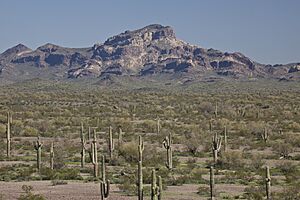
Phoenix has a hot desert climate. It's typical of the Sonoran Desert. Phoenix has long, very hot summers and short, mild winters. It's one of the sunniest places on Earth, with over 3,800 hours of sunshine each year.
Summer high temperatures are the hottest of any major U.S. city. On average, it gets to at least 100°F (38°C) for 111 days a year. It can even reach over 110°F (43°C) about 21 days a year. The highest temperature ever recorded was 122°F (50°C) on June 26, 1990. In July 2023, Phoenix had its hottest month ever, with an average temperature of 102.7°F (39.3°C). It also had a record 31 days in a row with highs over 110°F (43°C).
It rarely snows in Phoenix. The temperature almost never drops to 32°F (0°C). Because of the extreme heat, almost all homes in Phoenix have air conditioning.
Phoenix can have high levels of air pollution. This includes ozone and tiny particles. These particles can come from car exhaust or dust storms. Being exposed to high levels of dust can cause a lung infection called Valley Fever.
The city's growth has caused an "urban heat island" effect. Pavement and buildings store the sun's heat. This makes nighttime temperatures higher. Average summer low temperatures have been rising.

Phoenix gets very little rain, averaging about 7.22 inches (183 mm) per year. The dry, sunny weather is sometimes broken by winter storms. In summer, the North American monsoon brings higher humidity. This can cause heavy rain, flash floods, hail, strong winds, and dust storms. Sometimes these dust storms are so big they are called haboobs.
| Climate data for Phoenix Int'l, Arizona (1981–2010 normals, extremes 1895–present) | |||||||||||||
|---|---|---|---|---|---|---|---|---|---|---|---|---|---|
| Month | Jan | Feb | Mar | Apr | May | Jun | Jul | Aug | Sep | Oct | Nov | Dec | Year |
| Record high °F (°C) | 88 (31) |
92 (33) |
100 (38) |
105 (41) |
114 (46) |
122 (50) |
121 (49) |
117 (47) |
116 (47) |
107 (42) |
96 (36) |
87 (31) |
122 (50) |
| Mean maximum °F (°C) | 78.7 (25.9) |
82.8 (28.2) |
90.0 (32.2) |
98.6 (37.0) |
105.9 (41.1) |
112.5 (44.7) |
114.4 (45.8) |
112.5 (44.7) |
108.6 (42.6) |
100.1 (37.8) |
88.1 (31.2) |
77.1 (25.1) |
115.2 (46.2) |
| Mean daily maximum °F (°C) | 67.2 (19.6) |
70.7 (21.5) |
76.9 (24.9) |
85.2 (29.6) |
94.8 (34.9) |
103.9 (39.9) |
106.1 (41.2) |
104.4 (40.2) |
99.8 (37.7) |
88.5 (31.4) |
75.5 (24.2) |
66.0 (18.9) |
86.6 (30.3) |
| Daily mean °F (°C) | 56.4 (13.6) |
59.7 (15.4) |
65.2 (18.4) |
72.7 (22.6) |
82.1 (27.8) |
90.8 (32.7) |
94.8 (34.9) |
93.6 (34.2) |
88.4 (31.3) |
76.7 (24.8) |
64.1 (17.8) |
55.4 (13.0) |
75.1 (23.9) |
| Mean daily minimum °F (°C) | 45.6 (7.6) |
48.7 (9.3) |
53.5 (11.9) |
60.2 (15.7) |
69.4 (20.8) |
77.7 (25.4) |
83.5 (28.6) |
82.7 (28.2) |
76.9 (24.9) |
64.8 (18.2) |
52.7 (11.5) |
44.8 (7.1) |
63.4 (17.4) |
| Mean minimum °F (°C) | 36.2 (2.3) |
39.4 (4.1) |
43.2 (6.2) |
49.5 (9.7) |
58.0 (14.4) |
68.4 (20.2) |
73.7 (23.2) |
73.7 (23.2) |
67.1 (19.5) |
53.6 (12.0) |
40.8 (4.9) |
34.6 (1.4) |
33.5 (0.8) |
| Record low °F (°C) | 16 (−9) |
24 (−4) |
25 (−4) |
35 (2) |
39 (4) |
49 (9) |
63 (17) |
58 (14) |
47 (8) |
34 (1) |
27 (−3) |
22 (−6) |
16 (−9) |
| Average precipitation inches (mm) | 0.91 (23) |
0.92 (23) |
0.99 (25) |
0.28 (7.1) |
0.11 (2.8) |
0.02 (0.51) |
1.05 (27) |
1.00 (25) |
0.64 (16) |
0.58 (15) |
0.65 (17) |
0.88 (22) |
8.03 (204) |
| Average precipitation days (≥ 0.01 in) | 4.1 | 4.4 | 3.9 | 1.7 | 1.0 | 0.5 | 4.2 | 5.0 | 2.8 | 2.5 | 2.6 | 3.9 | 36.6 |
| Average relative humidity (%) | 50.9 | 44.4 | 39.3 | 27.8 | 21.9 | 19.4 | 31.6 | 36.2 | 35.6 | 36.9 | 43.8 | 51.8 | 36.6 |
| Mean monthly sunshine hours | 256.0 | 257.2 | 318.4 | 353.6 | 401.0 | 407.8 | 378.5 | 360.8 | 328.6 | 308.9 | 256.0 | 244.8 | 3,871.6 |
| Percent possible sunshine | 81 | 84 | 86 | 90 | 93 | 95 | 86 | 87 | 89 | 88 | 82 | 79 | 87 |
| Source: NOAA (relative humidity and sun 1961–1990) , Weather.com | |||||||||||||
People and Culture in Phoenix
| Historical population | |||
|---|---|---|---|
| Census | Pop. | %± | |
| 1870 | 240 | — | |
| 1880 | 1,708 | 611.7% | |
| 1890 | 3,152 | 84.5% | |
| 1900 | 5,544 | 75.9% | |
| 1910 | 11,314 | 104.1% | |
| 1920 | 29,053 | 156.8% | |
| 1930 | 48,118 | 65.6% | |
| 1940 | 65,414 | 35.9% | |
| 1950 | 106,818 | 63.3% | |
| 1960 | 439,170 | 311.1% | |
| 1970 | 581,572 | 32.4% | |
| 1980 | 789,704 | 35.8% | |
| 1990 | 983,403 | 24.5% | |
| 2000 | 1,321,045 | 34.3% | |
| 2010 | 1,445,632 | 9.4% | |
| 2020 | 1,608,139 | 11.2% | |
| 2023 (est.) | 1,650,070 | 14.1% | |
| U.S. Decennial Census 2010–2020 |
|||
As of 2020, Phoenix was the fifth most populated city in the United States. Its population was 1,608,139. The Phoenix metropolitan area is the 11th largest in the U.S. It has about 4.85 million people.
The population of Phoenix is almost evenly split between men and women. The average age in the city is 32.2 years old. Most people in Phoenix live in households with an average of 2.77 people.
The median household income in Phoenix was $47,866. About 21.8% of the population lived below the poverty line.
Diverse Backgrounds in Phoenix
Phoenix has a very diverse population. According to the 2020 census:
- White people make up 49.7% of the population.
- Black or African American people are 7.8%.
- Native American people are 2.6%.
- Asian people are 4.1%.
- People of two or more races are 15.5%.
Hispanic or Latino people make up 41.1% of the population. Most of them are of Mexican heritage. Phoenix also has the largest urban Native American population in Arizona.
Many different languages are spoken in Phoenix. In 2010, about 63.5% of people spoke only English at home. About 30.6% spoke Spanish.
Religious Life in Phoenix
Most people in Phoenix identify as Christians. About 66% of the population are Christians. About 26% say they have no religious affiliation. Other religions like Judaism, Buddhism, Islam, and Hinduism make up about 7%.
In 2010, among those who identified with a religious group, 35% were Catholic. Other large groups included Evangelical Protestant denominations and Latter-Day Saints (LDS).
Phoenix's Economy
Phoenix's early economy was based on farming and natural resources. These included copper, cattle, climate, cotton, and citrus. These were known as the "5Cs." The city became easier to reach with the opening of the Union Station in 1923 and the Sky Harbor airport in 1928.
After World War II, Phoenix's economy grew a lot. Many soldiers who trained in Arizona moved back with their families. This led to a boom in construction. Sun City, a community for retirees, became a model for other places.
The financial crisis of 2007–10 hurt Phoenix's economy. Construction stopped, and housing prices fell. But by 2015, the number of jobs had returned to pre-recession levels.
As of 2017, the main industries in Phoenix were real estate, finance and insurance, manufacturing, retail trade, and health care. Government jobs also make up a big part of the workforce.
Phoenix is home to several large companies. These include electronics company Avnet, mining company Freeport-McMoRan, and retailer PetSmart. Honeywell's Aerospace division is also based here. Intel has one of its largest sites in the area. Other companies like U-HAUL International and Best Western are headquartered in Phoenix.
Arts and Culture in Phoenix
Performing Arts
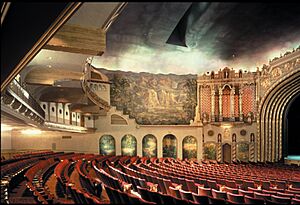
Phoenix has many places for performing arts. Most are in downtown Phoenix or Scottsdale. The Phoenix Symphony Hall is home to the Phoenix Symphony Orchestra and the Arizona Opera. The Orpheum Theatre also hosts performances. Ballet Arizona performs at these venues too.
The Herberger Theater Center has three performance spaces. It is home to the Arizona Theatre Company and the Centre Dance Ensemble. Many concerts are held at places like Footprint Center and Comerica Theatre.
Several TV shows have been set in Phoenix. These include Alice and Medium.
Museums to Explore
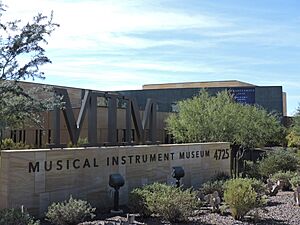
The Phoenix area has many museums. Some popular ones are the Phoenix Art Museum, Arizona Capitol Museum, and Arizona Science Center. The Heard Museum focuses on Native American art and culture.
In 2010, the Musical Instrument Museum opened. It has the world's largest collection of musical instruments. The Children's Museum of Phoenix was named one of the top three children's museums in the U.S. in 2015.
The Phoenix Art Museum has the largest collection of visual art in the Southwest. It has over 17,000 works of modern and contemporary art.
Art and Architecture
The Artlink organization hosts a "First Friday" event. Galleries across Phoenix open their doors for visitors. In 2009, artist Janet Echelman created Her Secret Is Patience. This large netted sculpture hangs above Phoenix Civic Space Park. It changes color at night and shows the patterns of the desert wind.
Phoenix has a unique architectural style. Frank Lloyd Wright built his winter home, Taliesin West, here in 1937. Many other famous architects have also lived and worked in Phoenix. They design buildings that fit the desert climate.
Fun for Tourists
Tourism is one of Phoenix's oldest and most important industries. The city has nearly 28,000 hotel rooms. Over 19 million people visit Phoenix each year. Most of them are leisure travelers. Sky Harbor Airport serves about 45 million passengers a year.
One of the biggest attractions is golf, with over 200 golf courses. There are also many attractions near Phoenix. These include Agua Fria National Monument and Casa Grande Ruins National Monument. Phoenix is also a good starting point to visit places like the Grand Canyon and Sedona.
Other Attractions and Events
Phoenix has many outdoor attractions. The Phoenix Zoo is the largest privately owned non-profit zoo in the U.S. It works to save endangered species. The Phoenix Botanical Gardens has the largest collection of desert plants in the U.S. South Mountain Park is the largest municipal park in the U.S. It's great for hiking, biking, and climbing.
Other popular spots include the Japanese Friendship Garden, Historic Heritage Square, and Camelback Mountain. You can also visit Hole in the Rock and Mystery Castle.
Phoenix hosts many annual events. These include the Scottsdale Arabian Horse Show and Matsuri, a Japanese culture celebration. The Arizona State Fair has been held since 1884.
Delicious Food in Phoenix
Phoenix is famous for its Mexican food. This is because of its large Hispanic population and closeness to Mexico. Many Mexican restaurants have been around for a long time.
The city's growth has brought people from all over the world. This has led to many different types of food. You can find barbecue, Cajun, Greek, Japanese, Italian, and many other international foods.
The first McDonald's franchise was sold to a Phoenix person in 1952. This was two years before Ray Kroc bought McDonald's. The first McDonald's with the famous golden arches was in Phoenix.
Sports in Phoenix
Major League Sports Teams
Phoenix is home to several professional sports teams. It is one of the few U.S. cities with teams in all four major professional sports leagues. However, only one team actually has "Phoenix" in its name.
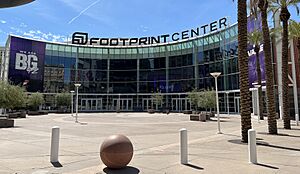
The Phoenix Suns were the first major sports team in Phoenix. They joined the NBA in 1968. They play at the Footprint Center in downtown Phoenix. They made it to the NBA Finals in 1993 and 2021.
The Arizona Diamondbacks are a Major League Baseball team. They started in 1998. They play at Chase Field in downtown Phoenix. In 2001, the Diamondbacks won the World Series. This was the first national championship for a professional sports team in Arizona.
The Arizona Cardinals are a professional football team. They moved to Phoenix from St. Louis in 1988. They play in the NFL. Since moving to Phoenix, they played in Super Bowl XLIII in 2009. They lost to the Pittsburgh Steelers. State Farm Stadium has hosted three Super Bowls.
The Arizona Coyotes were a National Hockey League team. They moved to the area in 1996. They played at Mullett Arena on the Arizona State University campus. In 2024, the team's operations were moved to Salt Lake City. The Coyotes have a chance to return to Phoenix if a new arena is built.
Phoenix Rising FC is a professional soccer team. They play in the USL Championship. They started in 2014 and play at the Phoenix Rising Soccer Stadium.
| Club | Sport | Year started operations | League | Venue | Titles |
|---|---|---|---|---|---|
| Arizona Cardinals | Football | 1988* | NFL | State Farm Stadium | 2* |
| Arizona Diamondbacks | Baseball | 1998 | MLB | Chase Field | 1 |
| Phoenix Suns | Basketball | 1968 | NBA | Footprint Center | 0 |
| Phoenix Mercury | Basketball | 1997 | WNBA | Footprint Center | 3 |
| Arizona Rattlers | Indoor football | 1992 | IFL | Desert Diamond Arena | 7 |
| Phoenix Rising FC | Soccer | 2014 | USLC | Phoenix Rising Soccer Stadium | 1 |
*Note: The Cardinals won their two pre-modern era championships while in Chicago. *Note: The Cardinals moved to Phoenix from St. Louis in 1988.
Other Sports Fun
Phoenix hosts two college football bowl games: the Fiesta Bowl and the Rate Bowl.
The Arizona Rattlers are an indoor football team. They play at the Desert Diamond Arena. They have won several championships.
The Phoenix Mercury are a WNBA team. They started in 1997 and play at Footprint Center. They have won the WNBA championship three times.
The Phoenix area is home to the Cactus League. This is where many Major League Baseball teams do their spring training. Half of MLB's 30 teams train here.
Phoenix International Raceway hosts several NASCAR events each year. The city also hosts major professional golf events, like The Phoenix Open. The Phoenix Marathon is a newer event that is a qualifier for the Boston Marathon.
Parks and Outdoor Fun
Phoenix has many parks and recreation areas. The city park system works to protect the desert landscape. South Mountain Park is the largest municipal park in the U.S. It covers over 16,500 acres. The park system has places for hiking, camping, swimming, and cycling. Other famous parks include Camelback Mountain and Encanto Park.
Papago Park is in east Phoenix. It is home to the Desert Botanical Garden and the Phoenix Zoo. The Desert Botanical Garden has desert plants from all over the world. The Phoenix Zoo is known for its work to save endangered animals.
Learning and Education
Phoenix has many school districts for public education. This is because many smaller areas joined Phoenix over the years. There are 21 elementary school districts and four high school districts. The Phoenix Union High School District is one of the largest in the country. It has 16 schools and over 27,000 students. There are also many charter schools in the city.
Colleges and Universities
Arizona State University (ASU) is the biggest university in the region. Its main campus is in Tempe, but it has a large campus in downtown Phoenix. This campus has programs like the Walter Cronkite School of Journalism and Mass Communication. Over 10,000 students attend ASU's Downtown Phoenix campus.
The University of Arizona College of Medicine – Phoenix is also downtown. The Maricopa County Community College District has ten community colleges. Phoenix College is the oldest community college in Arizona.
Other schools include Phoenix Seminary and Grand Canyon University. The University of Phoenix is also based in the city.
Media and Entertainment
Phoenix's first newspaper was the Salt River Valley Herald, started in 1878. Today, the main daily newspaper is The Arizona Republic. There are also many free local papers and alternative weeklies.
The Phoenix area has many local TV stations. It is the 12th largest TV market in the U.S. Major network channels include CBS, The CW, PBS, Fox, NBC, and ABC.
Many movies and TV shows have been filmed in Phoenix. Scenes from Psycho and The War of the Worlds were filmed here. Other movies include Raising Arizona and Bill & Ted's Excellent Adventure.
Phoenix radio stations play many types of music and talk shows. There are classic rock, pop, and country stations. With a large Hispanic population, there are also many Spanish radio stations.
City Services and Transportation
Getting Around Phoenix
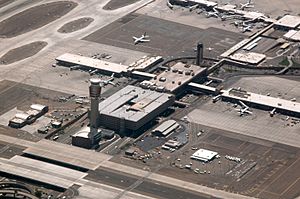
Phoenix Sky Harbor International Airport is one of the ten busiest airports in the United States. It serves over 110,000 people daily. It has non-stop flights to more than 100 cities. Many international airlines also fly here.
The Phoenix-Mesa Gateway Airport in Mesa also handles commercial flights. Smaller airports like Phoenix Deer Valley Airport are used for private jets.
Amtrak train service used to stop at Phoenix Union Station. Now, passengers take a bus to Maricopa to catch trains. Greyhound bus service also stops in Phoenix.
Valley Metro provides public transportation. This includes trains, buses, and a ride-share program. The Valley Metro Rail is a 20-mile light rail system. It opened in 2008 and runs through Phoenix, Tempe, and Mesa. More rail lines are planned for the future.
Roads and Freeways
Phoenix has a large system of freeways and streets. The freeways are managed by the Arizona Department of Transportation (ADOT). Phoenix has some of the best urban freeways in the country. They don't have as much traffic as other big cities. This is partly because the freeway system is very extensive.
The freeway system includes Interstate 10, Interstate 17, and several state routes. The streets in Phoenix are laid out in a grid. Most roads run north-south or east-west. Central Avenue and Washington Street are the starting point for numbering streets.
 I-10
I-10 I-17
I-17 SR 51
SR 51 US 60
US 60 SR 85
SR 85 Loop 101
Loop 101 SR 143
SR 143 Loop 202
Loop 202 Loop 303
Loop 303
The city also works to make cycling better. There are committees focused on improving bike paths and streets for cyclists.
Water and Electricity
Since Phoenix is in the desert, it needs a good water supply. Most of the city's water comes from the Colorado River. It is brought to Phoenix through the Central Arizona Project canal system.
Electricity for Phoenix comes mainly from Arizona Public Service. Some customers get electricity from the Salt River Project (SRP). Power plants use nuclear and coal to make electricity. Arizona is home to the Palo Verde Nuclear Generating Station, the largest nuclear power plant in the U.S. SRP is also the biggest water provider in Phoenix.
Famous People from Phoenix
Many notable people have come from Phoenix.
Phoenix's Sister Cities
Phoenix has a "Sister City" program. It started in 1972. The goal is to build friendships and understanding with cities around the world. Phoenix has twelve sister cities. Its first agreement was with Hermosillo, Mexico in 1976.
 Calgary, Alberta, Canada (1997)
Calgary, Alberta, Canada (1997) Catania, Sicily, Italy (2001)
Catania, Sicily, Italy (2001) Chengdu, Sichuan, China (1987)
Chengdu, Sichuan, China (1987) Ennis, County Clare, Ireland (1988)
Ennis, County Clare, Ireland (1988) Grenoble, Auvergne-Rhône-Alpes, France (1990)
Grenoble, Auvergne-Rhône-Alpes, France (1990) Hermosillo, Sonora, Mexico (1976)
Hermosillo, Sonora, Mexico (1976) Himeji, Hyōgo, Japan (1976)
Himeji, Hyōgo, Japan (1976) Prague, Czech Republic (2013)
Prague, Czech Republic (2013) Ramat Gan, Israel (2005)
Ramat Gan, Israel (2005) Taipei, Taiwan (1979)
Taipei, Taiwan (1979) Suwon, South Korea (2022)
Suwon, South Korea (2022) Medellin, Colombia (2023)
Medellin, Colombia (2023)
See also
 In Spanish: Phoenix para niños
In Spanish: Phoenix para niños














